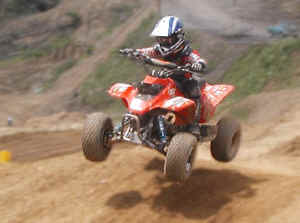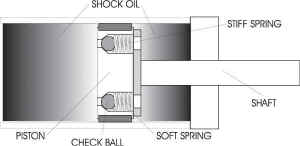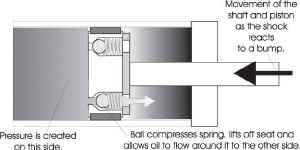Stock vs Performance When it comes to a mini-quad suspension, the manufacturers not only have to design a shock to handle the worst case scenarios such as really heavy riders hitting really hard jumps, but they need to do it in a cost effective manner. And the needs of most recreational riders are quite different than a racer or aggressive trail rider. The reality is that very few youth ATVs (maybe less than 10%) will ever be used in competition. Why inflate the cost of the machine by another five hundred dollars to satisfy the needs of the minority purchaser?
|
|
| A comparison of stock Kasea front shock (top) and Works front shocks. |
How Shock Absorbers Work The role of the ATV shock absorber is two-fold: to support the weight of the ATV in a resilient manner, and to dampen the motion of the wheel. The first part is relatively easy- that's what the spring is for. The second part is usually what's absent on stock shocks and where all the technology and sophistication lies.
| When the shock is not moving the pressure on each side of the piston is the same. The check ball acts as a valve sealing the piston. Behind each ball (there are three) are springs which are all different- going from light to stiff. The stiffness of the spring determines how much pressure will have to be created to open the valve. |
| When the quad hits a bump, the shock shaft starts to move through the oil. This causes pressure on the front side of the piston. How fast the shaft moves determines how much pressure there is. If the piston is moving slowly, then only one ball compresses its spring and allows oil to flow around it. If the piston moves quickly (higher pressure) then more than one ball will open allowing more oil to the other side of the piston. |
Proof is in the
Puddin'
Installation of the shocks is
dead simple- in our Kasea Skyhawk project machine they were a
drop-in, direct replacement. Works Performance was provided with
the particulars of the intended machine which in our case meant
informing them that we had +2 A-arms, stock tires/wheels, and a
stock swingarm. This info is critical in calculating the leverage
ratios between wheels and springs. Should this data ever change (or
rider details), Works can revalve the shocks to compensate.
After installation, the difference was immediately
noticed by simply doing the "garage test" of bouncing on the pegs;
the quad moved up and down easily with much more effective travel.
Picking up the rear end of the machine and dropping it from a
distance of a couple feet returned a buttery "pooof". Even at this
point, the new shocks seemed night and day different than the
stockers.
But a testimonial from the
machine's young pilot would be the final word, so off we went to
the track with "Zack-man", our 7 year-old test rider at the
controls.
After a few laps of the AMA
motocross track, we quizzed the speechless Zack-man on the virtues
of the new suspension:
Kids Korner:
So, Zack, what do you think of the new shocks?
Zack-man: "...uhh,... well, ... they were great."
Translation: The Works shocks worked beautifully. With the added
suspension travel and compliance they made me more confident over
jumps, and actually improved my lap times.
 |
| Zackman taking the re-sprung Kasea through the rhythm section. |
Zack-man: "yah. totally"
Translation: The two are not even in the same category. When I used to come down on jumps it was brutal, sometimes coming down so hard I'd nearly bash my helmet in the bars, and then nearly crash as I try to recover. The Works shocks are like a breath of fresh air. Kids Korner: "Any remaining comments?"
Zack-man: "uhmm..."
Translation: The Works shocks are quality pieces- machined billet aluminum ends, nitrogen charged, oil-emulsion shocks that are likely to suck up all the punishment I intend to serve them! Zack-man: "Can I have some ice cream now?" >>>> Next Month- The finishing touches such as steering dampers, chain tensioners, and extended swingarms.
| • Contact Information |
 Works Shocks
Works Shocks
21045 Osborne Street Canoga Park, CA, 91304 Phone (818) 701-1010 Fax (818) 701-9043 |




 Your Privacy Choices
Your Privacy Choices